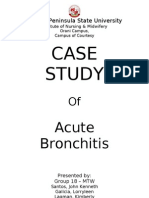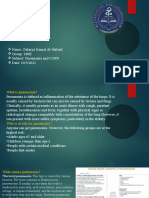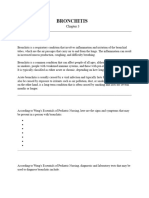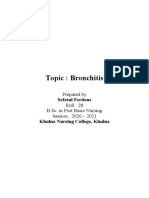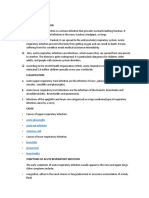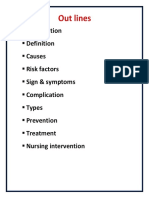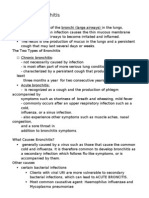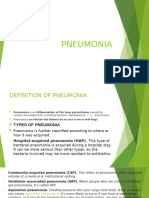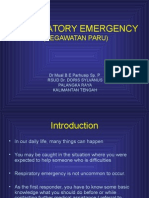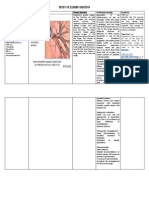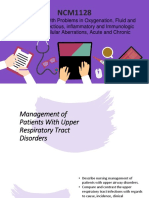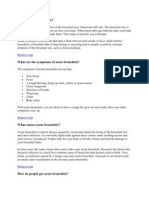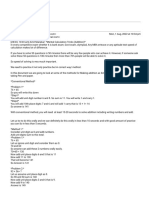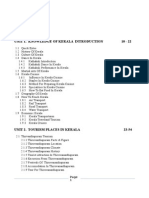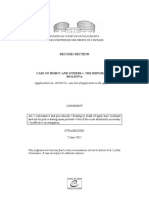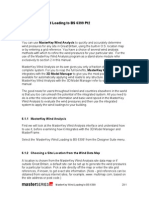0 ratings0% found this document useful (0 votes)
17 viewsAcute Bronchitis Case Presentation
Acute Bronchitis Case Presentation
Uploaded by
Francine kimberlyAcute bronchitis is an inflammation of the bronchi caused by viruses or bacteria. It involves cough with or without mucus production that typically resolves within 1-3 weeks. Prevention includes hand washing, vaccinations, avoiding smoking and irritants. Treatment focuses on relieving symptoms through cough medicine, fluids, rest and antibiotics in some cases. Nursing care monitors for worsening and teaches measures to thin secretions and promote recovery.
Copyright:
© All Rights Reserved
Available Formats
Download as PDF, TXT or read online from Scribd
Acute Bronchitis Case Presentation
Acute Bronchitis Case Presentation
Uploaded by
Francine kimberly0 ratings0% found this document useful (0 votes)
17 views1 pageAcute bronchitis is an inflammation of the bronchi caused by viruses or bacteria. It involves cough with or without mucus production that typically resolves within 1-3 weeks. Prevention includes hand washing, vaccinations, avoiding smoking and irritants. Treatment focuses on relieving symptoms through cough medicine, fluids, rest and antibiotics in some cases. Nursing care monitors for worsening and teaches measures to thin secretions and promote recovery.
Original Title
ACUTE-BRONCHITIS-CASE-PRESENTATION
Copyright
© © All Rights Reserved
Available Formats
PDF, TXT or read online from Scribd
Share this document
Did you find this document useful?
Is this content inappropriate?
Acute bronchitis is an inflammation of the bronchi caused by viruses or bacteria. It involves cough with or without mucus production that typically resolves within 1-3 weeks. Prevention includes hand washing, vaccinations, avoiding smoking and irritants. Treatment focuses on relieving symptoms through cough medicine, fluids, rest and antibiotics in some cases. Nursing care monitors for worsening and teaches measures to thin secretions and promote recovery.
Copyright:
© All Rights Reserved
Available Formats
Download as PDF, TXT or read online from Scribd
Download as pdf or txt
0 ratings0% found this document useful (0 votes)
17 views1 pageAcute Bronchitis Case Presentation
Acute Bronchitis Case Presentation
Uploaded by
Francine kimberlyAcute bronchitis is an inflammation of the bronchi caused by viruses or bacteria. It involves cough with or without mucus production that typically resolves within 1-3 weeks. Prevention includes hand washing, vaccinations, avoiding smoking and irritants. Treatment focuses on relieving symptoms through cough medicine, fluids, rest and antibiotics in some cases. Nursing care monitors for worsening and teaches measures to thin secretions and promote recovery.
Copyright:
© All Rights Reserved
Available Formats
Download as PDF, TXT or read online from Scribd
Download as pdf or txt
You are on page 1of 1
ACUTE BRONCHITIS Prevention • Inhaled bronchodilators to reduce bronchospasm and
Definition • Clean your hands. promote sputum expectoration.
Acute bronchitis, a prevalent respiratory infection, is • Get recommended vaccines, such as the flu vaccine. • A course of oral antibiotics such as a macrolide may be
a significant medical concern, particularly among • Don’t smoke and avoid exposure to secondhand smoke instituted, but is controversial.
adult patients. This condition involves the lower • Cover your mouth and nose when coughing or sneezing. • Symptom management for fever and cough.
respiratory tract, specifically targeting the bronchi, • Cough medicine Nursing Interventions:
the prominent air passages responsible for air • Increased fluid intake • Conduct respiratory assessment to monitor for changes in
transport within the lungs. Acute bronchitis • Pain relievers and fever reducers, such as acetaminophen respiratory status, such as increased cough, sputum
manifests as an inflammation of these bronchi (Tylenol) production, or changes in breath sounds.
without evidence of pneumonia and typically affects • Avoid antihistamines because they dry up the secretions • Encourage mobilization of secretion through ambulation,
individuals without underlying chronic obstructive and can make the cough worse. coughing, and deep breathing.
pulmonary disease (COPD). Acute bronchitis is • Minimize exposure to allergens and pollutants, they are • Ensure adequate fluid intake to liquefy secretions and
characterized by an acute onset of a persistent essential in preventing the recurrence of acute bronchitis prevent dehydration caused by fever and tachypnea.
cough, with or without sputum production. As a self- and reducing the risk of complications. • Encourage rest, avoid bronchial irritants, and a good diet to
limiting condition, it typically follows a benign • Run a humidifier. Moist air is less likely to irritate your lungs. facilitate recovery.
course, resolving spontaneously over 1 to 3 weeks. • Make sure you are up-to-date on flu and pneumonia • Instruct the patient to complete the full course of
vaccines. prescribed antibiotics and explain the effect of meals on
Signs and Symptoms Laboratory drug absorption.
Back and muscle pain, Cough, first dry (non- • Chest X-rays. This test makes images of internal tissues, • Caution the patient on using over-the-counter cough
productive), later, lot of mucus is produced bones, and organs. suppressants, antihistamines, and decongestants, which
Chest soreness, Chills, Malaise, Feeling tired and • Pulse oximetry. An oximeter is a small device that measures may cause drying and retention of secretions. However,
achy, Headache, Runny nose, Slight fever, Shortness the amount of oxygen in the blood. For this test, the cough preparations containing the mucolytic guaifenesin
of breath, Sore throat, Watery eyes, Wheezing healthcare provider puts a small sensor (like a clip) on your may be appropriate.
• Advise the patient that a dry cough may persist after
child's finger or toe. When the device is on, a small red light
Causes can be seen in the sensor. The sensor is painless, and the bronchitis because of irritation of airways. Suggest avoiding
Acute bronchitis is usually caused by infectious red light does not get hot. dry environments and using a humidifier at bedside.
agents such as bacteria or viruses. It may also be Encourage smoking cessation.
• Pulmonary function tests. These are tests that help to
caused by physical or chemical agents minus; dusts, • Teach the patient to recognize and immediately report early
measure how well the lungs move air in and out.
allergens, strong fumes, and those from chemical signs and symptoms of acute bronchitis.
• Sputum and nasal discharge samples. These tests can find
cleaning compounds, or tobacco smoke. (Acute • Use a humidifier or steam. A hot shower can be great for
the germ causing an infection.
asthmatic bronchitis may happen as the result of an loosening mucus.
• Complete blood count (CBC). This test identifies signs of
asthma attack, or it may be the cause of an asthma • Drink a lot of water. Eight to 12 glasses a day helps thin out
infection, such as an elevated white blood cell count.
attack.) In children, the most common cause of your mucus and makes it easier to cough it up.
• Bronchoscopy. This test gives direct visualization of airways
bronchitis is a virus, although in children over 6 years • Encourage patient/caregiver to schedule follow-up
through a thin tube, with possible fluid/tissue sampling.
of age, it can be caused by bacteria. Acute bronchitis appointments to monitor progress, to adjust the care plan
is usually a mild condition. as needed, and provide ongoing support,
Causes: Bacteria, Viruses, Chemical or Medical Management:
physical agents - dusts, allergens, strong fumes, • Chest physiotherapy to mobilize secretions, if indicated.
tobacco smoke • Hydration to liquefy secretions.
Pharmacologic Interventions:
You might also like
- Rose Martin - 2012 - Learning To Write, Reading To Learn - Chap1Document30 pagesRose Martin - 2012 - Learning To Write, Reading To Learn - Chap1ginger_201167% (3)
- Case Study of BronchitisDocument34 pagesCase Study of Bronchitisken83% (29)
- Chronic BronchitisDocument11 pagesChronic BronchitisNazurah AzmiraNo ratings yet
- Upper Respiratory Tract InfectionsDocument73 pagesUpper Respiratory Tract Infectionsankita100% (1)
- Astm e 2930 - 13Document8 pagesAstm e 2930 - 13Martin Chimenti - ARO SA100% (1)
- Bronchitis 2nd YrDocument14 pagesBronchitis 2nd YrridijaNo ratings yet
- DirectFileTopicDownload-4Document84 pagesDirectFileTopicDownload-4sesaeedhaniyah.dNo ratings yet
- Day 15 - NCM-109 Children With Alteration in Oxygenation (A)Document50 pagesDay 15 - NCM-109 Children With Alteration in Oxygenation (A)Sheena Patricia ArasulaNo ratings yet
- Case Study: Acute BronchitisDocument34 pagesCase Study: Acute BronchitisJeffany Anne Rabaya Retirado0% (1)
- CoughDocument31 pagesCoughkoreamydream85No ratings yet
- Chemotherapy ComplicationDocument21 pagesChemotherapy ComplicationDr ZakaryaNo ratings yet
- Pneumonia Case PresentationDocument1 pagePneumonia Case PresentationFrancine kimberlyNo ratings yet
- BronchiectasisDocument20 pagesBronchiectasisSajjal JohnsonNo ratings yet
- Bronchitis 170709131740Document28 pagesBronchitis 170709131740Viji MNo ratings yet
- Woman With PneumoniaDocument9 pagesWoman With PneumoniaNohaira SADANGNo ratings yet
- Handouts-for-Respiratory-DiseasesDocument9 pagesHandouts-for-Respiratory-DiseasesKristina KatalbasNo ratings yet
- Chapter 5 LRTI PDFDocument73 pagesChapter 5 LRTI PDFHamza BarriNo ratings yet
- BRONCHITISDocument7 pagesBRONCHITISAlyssa Joyce TanNo ratings yet
- BronchiectasisDocument21 pagesBronchiectasisEliza ButtNo ratings yet
- Children With Respiratory DysfunctionDocument72 pagesChildren With Respiratory Dysfunctionftb2zsbzs2No ratings yet
- BronchitisDocument9 pagesBronchitisMS AntikaNo ratings yet
- Respiratory Disorders 1uk 2Document7 pagesRespiratory Disorders 1uk 2zainahalqahtani3No ratings yet
- Presentati ON ON Bronchitis: Presented by K.vani M.SC (N) 1st YearDocument30 pagesPresentati ON ON Bronchitis: Presented by K.vani M.SC (N) 1st Yearvani reddyNo ratings yet
- Respiratory Disorder Note BSC 3rd YearDocument41 pagesRespiratory Disorder Note BSC 3rd YearNancyNo ratings yet
- Pneumonia 3Document12 pagesPneumonia 3Dina M ElbakaryNo ratings yet
- Obcl-2-Cu - Week 3 BronchitisDocument9 pagesObcl-2-Cu - Week 3 BronchitisMichelle Gliselle Guinto MallareNo ratings yet
- Pneumonia 10Document13 pagesPneumonia 10Dina M Elbakary100% (1)
- Community Acquired PneumoniaDocument5 pagesCommunity Acquired PneumoniaLau ColastreNo ratings yet
- Lower Respiratory InfectionDocument71 pagesLower Respiratory Infectionpaulyn ramos100% (2)
- CHAPTER 48 The Child With Alterations in Respiratory FunctionsDocument49 pagesCHAPTER 48 The Child With Alterations in Respiratory Functionselsaqum98No ratings yet
- Gauxy ) )Document54 pagesGauxy ) )Gauxy AromboNo ratings yet
- Chronic BronchitisDocument14 pagesChronic BronchitisSidra ShoukatNo ratings yet
- Acute Bronchitis HandoutDocument5 pagesAcute Bronchitis HandoutDianne LegionNo ratings yet
- A Case Study of Bronchial Asthma in Acute Exacerbation (Baiae)Document10 pagesA Case Study of Bronchial Asthma in Acute Exacerbation (Baiae)Janina RojoNo ratings yet
- Nursing InterventionsDocument10 pagesNursing Interventionspaulinian_nurseNo ratings yet
- Bronchitis: Kelompok IDocument14 pagesBronchitis: Kelompok ILinda Permata Sari100% (1)
- Acute Bronchitis: Causes PathophysiologyDocument3 pagesAcute Bronchitis: Causes PathophysiologyAngeline de GalaNo ratings yet
- Respiratory System (Common Diseases)Document23 pagesRespiratory System (Common Diseases)Philip YansonNo ratings yet
- Cardiopulmonary Disorders in ChildrenDocument65 pagesCardiopulmonary Disorders in ChildrenJohn Paul MatillosaNo ratings yet
- Causes of PneumoniaDocument6 pagesCauses of PneumoniaMd Sherajul HaqueNo ratings yet
- An Overview of PTBDocument5 pagesAn Overview of PTBJb_Abarado_7467No ratings yet
- Pneumonia Is A Condition That Causes The Lungs To Become Inflamed As A Result of A BacterialDocument3 pagesPneumonia Is A Condition That Causes The Lungs To Become Inflamed As A Result of A BacterialDhonnalyn Amene CaballeroNo ratings yet
- PneumoniaDocument15 pagesPneumoniaLeina PrasadNo ratings yet
- Your Big IdeaDocument12 pagesYour Big Ideaapi-380169571No ratings yet
- Acute BroncitisDocument10 pagesAcute Broncitisraphael chidiebereNo ratings yet
- BronchitisDocument19 pagesBronchitisbkbaljeet116131No ratings yet
- PneumoniaDocument9 pagesPneumoniatimberlaake60No ratings yet
- Factsheet Acute Bronchitis Aug2018Document2 pagesFactsheet Acute Bronchitis Aug2018ikamentayaNo ratings yet
- Pneumonia BY JHANNADocument4 pagesPneumonia BY JHANNAESPINOSA JHANNANo ratings yet
- BronchitisDocument16 pagesBronchitisHussein AbduNo ratings yet
- Kul. 6 Respiratory EmegencyDocument46 pagesKul. 6 Respiratory EmegencyYusuf Almalik SaputraNo ratings yet
- PneumoniaDocument6 pagesPneumoniaczhuenaNo ratings yet
- Study of Illness ConditionDocument6 pagesStudy of Illness Conditionyong_gret100% (2)
- PERTUSSISDocument46 pagesPERTUSSISOrmin Ppo PphrddbNo ratings yet
- Management of Patients With Upper Respiratory Tract DisordersDocument93 pagesManagement of Patients With Upper Respiratory Tract DisordersErica Clerigo Landicho100% (1)
- PneumoniaDocument16 pagesPneumoniachris vincent buendiaNo ratings yet
- What Is Acute BronchitisDocument11 pagesWhat Is Acute BronchitisKerri-DojhnHallNo ratings yet
- II. Upper Respiratory Tract DisordersDocument98 pagesII. Upper Respiratory Tract Disordersarielleortuoste100% (2)
- Lower Respiratory Tract Upper Respiratory Tract Infection Bacterial InfectionDocument2 pagesLower Respiratory Tract Upper Respiratory Tract Infection Bacterial InfectionEimhie Lee CasiNo ratings yet
- Bronchiectasis, A Simple Guide To The Condition, Diagnosis, Treatment And Related ConditionsFrom EverandBronchiectasis, A Simple Guide To The Condition, Diagnosis, Treatment And Related ConditionsNo ratings yet
- Asthma: Symptoms, Treatments, and Medication for Asthma and BronchitisFrom EverandAsthma: Symptoms, Treatments, and Medication for Asthma and BronchitisNo ratings yet
- PROPERTY Module 2 CasesDocument92 pagesPROPERTY Module 2 CasesKIM COLLEEN MIRABUENANo ratings yet
- GM14Document2 pagesGM14bhaktiNo ratings yet
- Entrep q2 Mod8 Four Ms of Operation in Relation To Business OpportunityDocument13 pagesEntrep q2 Mod8 Four Ms of Operation in Relation To Business OpportunityAnatanya TironaNo ratings yet
- Rule 1 Civil ProcedureDocument78 pagesRule 1 Civil ProcedureKen AliudinNo ratings yet
- Mental Calculation TricksDocument19 pagesMental Calculation TricksHemant KumarNo ratings yet
- HIFU-Client-Pre-and-After-Care - 2Document4 pagesHIFU-Client-Pre-and-After-Care - 2Hanan AnsariNo ratings yet
- United States v. Tiffany Bolner, 4th Cir. (2012)Document4 pagesUnited States v. Tiffany Bolner, 4th Cir. (2012)Scribd Government DocsNo ratings yet
- Kerala TourismDocument116 pagesKerala Tourismneeraj67% (3)
- Unit 5 - Lesson 2 - Market Failure and ExternalitiesDocument10 pagesUnit 5 - Lesson 2 - Market Failure and Externalitiesapi-260512563No ratings yet
- MTB-MLE Lesson PlanDocument9 pagesMTB-MLE Lesson PlanGlessy AlvaroNo ratings yet
- Resurrection ChronologyDocument1 pageResurrection ChronologyPNWBizBrokerNo ratings yet
- Oracle HRMS Question e BookDocument37 pagesOracle HRMS Question e BookSyed Farhan Ashraf100% (1)
- Monologo y DialogoDocument3 pagesMonologo y DialogomanoloNo ratings yet
- 30) State Investment House vs. Intermediate Appellate Court, Et Al., G.R. No. 72764 July 13, 1989Document2 pages30) State Investment House vs. Intermediate Appellate Court, Et Al., G.R. No. 72764 July 13, 1989AlexandraSoledad100% (2)
- CriminiologyDocument24 pagesCriminiologyAbdullah AminNo ratings yet
- ADH8066 GSM Module AT-Commands v1.6Document79 pagesADH8066 GSM Module AT-Commands v1.6_Nishant_No ratings yet
- A Call To SalvationDocument35 pagesA Call To SalvationryecruzNo ratings yet
- GPRS ExplainedDocument11 pagesGPRS ExplainedAhmed Hamed BadrNo ratings yet
- Book 14 Feb 2024Document8 pagesBook 14 Feb 2024wrld.of.mirunaNo ratings yet
- Ethical RelativismDocument18 pagesEthical RelativismJohn P CartnellNo ratings yet
- Case of Boboc and Others v. The Republic of MoldovaDocument21 pagesCase of Boboc and Others v. The Republic of MoldovaDaniela DavîdovNo ratings yet
- Lesson Plan Template 2022-2023Document7 pagesLesson Plan Template 2022-2023juvelyn abugan100% (1)
- Naam Book 1Document141 pagesNaam Book 1sunrisegazer100% (1)
- MasterKey Wind Loading To BS 6399Document31 pagesMasterKey Wind Loading To BS 6399colbm100% (1)
- Vsfiltermod Tags NuevasDocument6 pagesVsfiltermod Tags NuevasASEDARKNo ratings yet
- Anaesthesia For Patients With Cardiac Disease Undergoing Non-Cardiac SurgeryDocument4 pagesAnaesthesia For Patients With Cardiac Disease Undergoing Non-Cardiac SurgeryRatu NabilaNo ratings yet
- The Endodontic Complexity Assessment Tool - E-CAT - 2021Document11 pagesThe Endodontic Complexity Assessment Tool - E-CAT - 2021bogdimNo ratings yet
- Line of Reasoning - APEs Paragraphs - AP LiteratureDocument10 pagesLine of Reasoning - APEs Paragraphs - AP LiteratureD KangNo ratings yet

